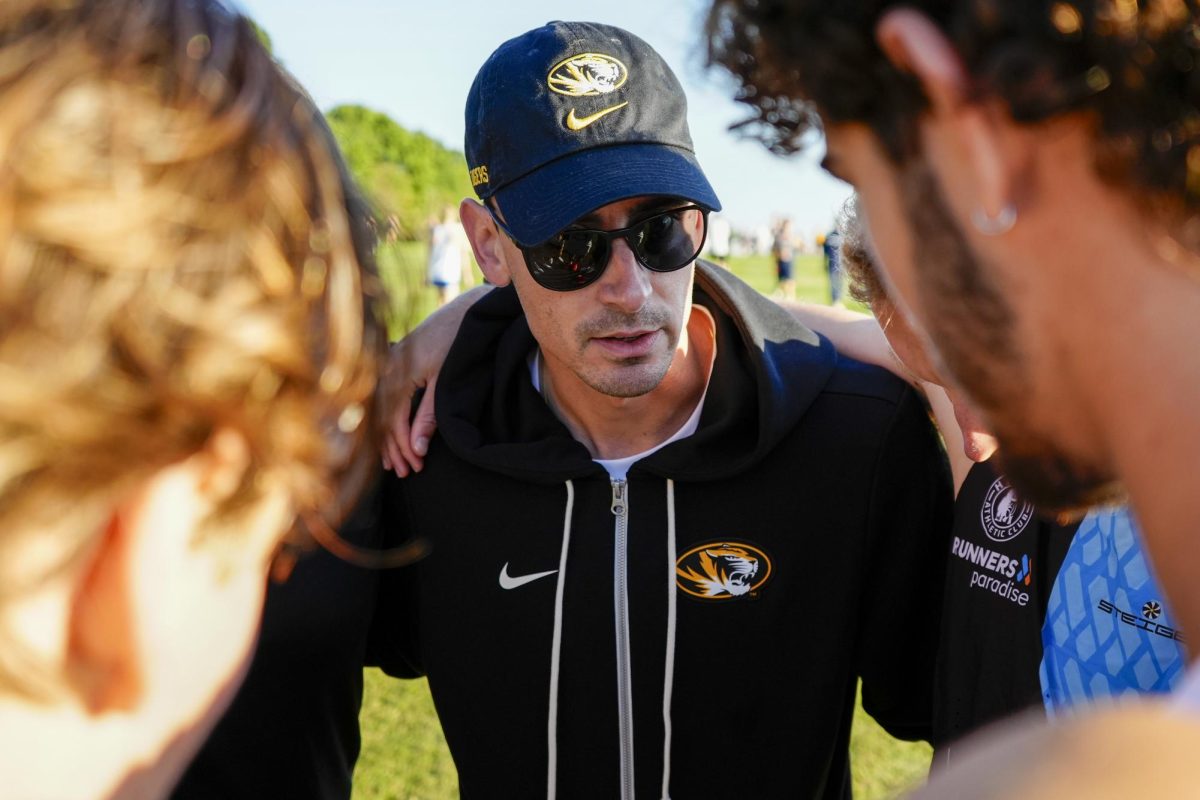Darrin Houck remembers his son Tanner hobbling around the pitcher’s mound.
Tanner was pitching in a tournament in Branson for his middle school select team, the Troy Thunder. The first batter he faced hit a rocket up the middle, and the line drive struck Houck’s knee.
Despite the pain, Tanner stayed in the game. In fact, the future Missouri Tiger pitched into the seventh inning and only allowed two hits.
“I think this is where I learned that he was going to be a type of kid that he’s not going to back down,” Darrin Houck said.
Now a 6-foot-5, 217-pound sophomore at Missouri, Tanner has received national recognition. After earning Freshman All-America honors in 2015, Houck posted a 2.16 earned run average pitching for the USA Collegiate National Team in the summer. Perfect Game, a baseball scouting website, ranked the Missouri sophomore as the No. 1 prospect for the 2017 MLB First-Year Player Draft.
Combined with his physical build and athleticism, Houck’s competitive spirit and mental toughness have helped him develop into one of college baseball’s top pitchers. If he can stay healthy and continue improving, the 19-year-old could have a long, professional career ahead of him.

Sophomore pitcher Tanner Hock looks towards left field from the dugout during the game against LSU on April 17.Photo by Jordan Kodner/Photo Editor
####The Fastball
There are pitchers in the Southeastern Conference who throw harder than Houck. But the movement on his premier pitch — the fastball — makes it deadly for hitters.
Kyle Gibson, a Minnesota Twins starting pitcher and 2009 first round pick out of Missouri, got a chance to watch Houck pitch during the Tigers’ spring trip to Florida.
“If you’re looking at a breaking ball or a change up, you have dual planes of movement,” Gibson said. “You can have it go down or you can have it go side to side. When a fastball has both of those on it, it becomes a pretty tough pitch to hit, especially when it’s moving late … 96 (mph) is already tough enough to hit in its own way, so when you add that in with the movement, it’s hard to square up and it’s pretty hard to take a couple good hacks at it.”
Coaches, teammates and experts have all commented on Houck’s fastball movement.
SEC Network analyst and former major league player Gabe Gross ranked Houck’s fastball as the best in the conference this month.
“He not only can throw hard, but he can locate the ball to both sides of the plate,” Gross said in an SEC Network segment. “And above everything else, he’s just got great movement on his pitches.”
In the offseason, the Collinsville, Illinois, native takes private pitching lessons from Brian DeLunas, the founder of Premier Pitching and Performance in St. Louis. DeLunas was a volunteer assistant at Missouri from 2006 to 2009.
DeLunas said that the effectiveness of Houck’s fastball makes his secondary pitches even harder to hit.
“You’re going to be facing mid 90s sink, and I think he’s going to be pretty aggressive in the zone,” DeLunas said. “But then you’re going to have to defend the slider, too.”
Brett Bond might know Houck’s fastball better than anyone else. The sophomore catcher has been behind the plate for all of Houck’s starts this season.
“Every weekend, it feels like his ball can do something different every time,” Bond said. “It can dive more, it can run more, it can maybe stay a little flatter.”
One of Houck’s strongest starts this season came April 8 against Auburn. The sophomore threw a complete game shutout, striking out 10 en route to a 2–0 Missouri win.
After the game, Houck said he worked on commanding all three of his pitches (fastball, changeup, slider) over the offseason. Against Auburn, he could control them all and mix up the types of pitches he threw.
“Fastball was huge,” he said. “(I) showed really early that I could command it for strikes with a lot of movement. So that was my go-to (pitch) tonight, and then backing it up with my slider whenever I needed it, knowing that I could get them to chase out of the zone occasionally, and then coming back in with the fastball.”
The scary thing for the rest of college baseball is that Houck is still improving. At only 19 years old, his slider and changeup will continue to get better.
“He knows how to control a baseball game, and he’s only a sophomore,” Gibson said. “The ceiling is the limit. It’s incredible. He’s got really good late life on his sinker. His off-speed is only going to develop more and more.”

Tanner and Darrin Houck pose for a picture during the summer of 2015. COURTESY OF DARRIN HOUCK
####The Hype
With pre-draft speculation, there has already been plenty of hype around Houck. This will only grow as the 2017 draft gets closer.
Gibson knows what it’s like to deal with pressure. As a former first-round pick, people had high expectations for him as he worked his way into the major leagues.
“The next year he’s going to have some lofty expectations … there’s a lot of pressure that comes with that,” Gibson said. “For him, it seems like he’s got a really good head on his shoulders.”
Gibson said that it is easy to get wrapped up in talk about the draft. However, he thinks that the process can be fun and exciting “if you have the right view on it.”
Darrin Houck said he takes the draft projections lightly. Although he acknowledges the high expectations for his son, he feels that it is an exciting time.
Darrin does not think Tanner is affected by the added hype of the draft.
“I still think that he is unaware of a lot of this outside pressure,” he said. “He keeps to himself a lot, doesn’t listen to all the media hype and such. So I think that he doesn’t hear about it as much as a lot of people outside do.”
Tanner said that being named the top draft prospect was an honor. With that said, he recognizes there’s a long time before the summer of 2017.
“I’ve got to continue to improve myself, whether that’s in the weight room, on the field, pitches, whatever it is,” he said in a preseason interview. “I’ve just got to stay hungry.”
Through 10 starts in 2016, Houck is still eating. He has a 3.20 earned run average with 75 strikeouts. He has been named SEC Pitcher of the Week twice and was one of 60 players nationally named to USA Baseball’s Golden Spikes Award midseason watch list. The award honors the top college player in the nation.
DeLunas feels that the hype around the sophomore is deserved.
“I’m going to be honest with you, pitching in the SEC at that level and being able to do what he does,” he said, “I think that’s some of what warrants some of that attention and some of that hype as a potential top-of-the-first-round type of guy.”
With the accolades and scouting reports rolling in, opposing players get excited to face Houck. This makes the right-handed pitcher’s job even tougher.
“He’s got that target on his back because he is projected to be the No. 1 next year,” said David Cronin, an Illinois-Chicago infielder who played against Houck. “And the fact that he does have that target on his back, every team is trying to give their best mentality right back at him.”

Tanner Houck pitches against Illinois-Chicago on March 5 at Taylor Stadium.Photo COURTESY OF MU ATHLETICS
####The Flaws
When Cronin and his UIC teammates came to Columbia for Missouri’s first home series of 2016, they planned to be aggressive against Houck. The Flames wanted to control the at-bats.
“We weren’t going to let him get ahead of us,” the sophomore second baseman said. “We knew if we were going to get down quickly, we were kind of in trouble just because he changes up his speeds and his angles.”
The Flames forced Houck to throw 103 pitches in seven innings. They tagged Houck for four runs (three earned), handing the sophomore his first loss of the season.
Cronin said that Houck did not have his best stuff in the game. The Flames were able to capitalize.
“I think as we got his pitch count up, because we kept getting a bunch of quality at bats early, we were sticking with him, as he got his pitch count up … his fastball was more straight,” Cronin said. “I don’t know if it was from exhaustion or what it was, but we were able to really fight with him.”
In college, starting pitchers generally throw once a week. In professional baseball, starters move to a five-day rotation.
DeLunas feels that there are adjustments Houck could make to help his durability.
“I think he could still, honestly, use his lower half a little bit more efficiently,” DeLunas said. “I think he can take a little bit of stress off the arm by doing that.”
Although there are elements of Houck’s game that he needs to work on, the sophomore has come a long way since coming to Missouri. Houck’s velocity has jumped from high 80s into the mid 90s. DeLunas said that the sophomore has put on about 50 pounds since his senior year of high school.
Pete Trapp coached Houck at Collinsville High School. He has been pleased with Houck’s progression.
“A lot of the stuff that I thought he needed to improve on, he actually has,” Trapp said. “It’s hard not to notice his velocity and how much that’s increased.”
Even with Tanner’s physical gains, Darrin Houck feels that his son can still try to add more muscle to his frame.
“He can always work at getting stronger, getting bigger,” Darrin said.
Gibson says that it’s always important for pitchers to work on consistency. He said that even major league pitchers are always striving to refine their craft.
The Twins’ pitcher is excited to see how Houck improves going forward.
“He’s going to have the rest of this year and next year to get better,” Gibson said. “That’s going to be the scary thing. He’s going to go out there and work hard over the next … 14 months, and it’s going to be pretty cool to see how good he gets a year and two months from now.”

Tanner Houck poses for a picture with Missouri junior Ryan Howard while playing for the USA Collegiate National Team in summer 2016. “He’s an awesome kid,” Howard said about Houck in a preseason interview. “I like to pick his brain, what he’s thinking. I can learn a lot from him as a hitter just knowing what he’s trying to do.”Photo Courtesy of MU Athletics
####The Future
The summer of 2017 will not be the first time Houck is drafted. After his senior year at Collinsville, he was taken in the 12th round of the 2014 draft, but he elected to attend Missouri instead of going pro.
Houck could earn a big payday in next year’s draft. In 2015, No. 1 overall pick Dansby Swanson earned a signing bonus of $6.5 million, and no first-round selection earned less than $1.25 million.
Houck’s projectable frame makes him appealing to clubs. His long arms and lanky stature help add torque — and thus velocity — to his pitches.
“He certainly has some physical attributes that … allows him to do some things that maybe look a little bit less orthodox than the average pitcher,” DeLunas said.
Houck’s prowess as a pitcher extends beyond his physical attributes. Trapp described him as a supportive teammate, and Missouri coach Tim Jamieson praised his demeanor on the mound.
“It’s a tool that’s not talked about enough, and it’s really the difference maker,” Jamieson said in a preseason interview. “At such a young age and such a big environment … we haven’t had anybody that did what he did as a freshman.”
One key for the sophomore’s draft future will be avoiding injury.
“I’m praying to God that he stays healthy … As long as he stays healthy, I think things will work out for him,” Darrin said.
Houck will play for the USA Collegiate National Team again this summer and then will head into what likely will be his final season as a Missouri Tiger.
DeLunas compared Houck to an artist with a blank canvas. When the sophomore combines all of his dominant elements — competitiveness, size and pitch movement — the coach sees an athlete who has a chance to be something special.
“If you’re a hitter and you want to be hitting off of Tanner, I think now’s the time to do it,” DeLunas said. “Because I think he’s just going to continue to get better as he goes.”
_Edited by Alec Lewis | [email protected]_













